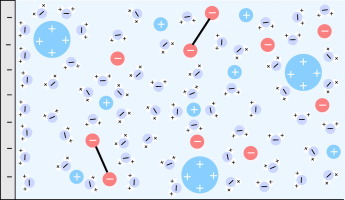Advances in Colloid and Interface Science ( IF 15.9 ) Pub Date : 2017-05-05 , DOI: 10.1016/j.cis.2017.05.001 Klemen Bohinc , Guilherme Volpe Bossa , Sylvio May

|
An electric double layer forms when the small mobile ions of an electrolyte interact with an extended charged object, a macroion. The competition between electrostatic attraction and translational entropy loss of the small ions results in a diffuse layer of partially immobilized ions in the vicinity of the macroion. Modeling structure and energy of the electric double layer has a long history that has lead to the classical Poisson-Boltzmann theory and numerous extensions that account for ion-ion correlations and structural ion and solvent properties. The present review focuses on approaches that instead of going beyond the mean-field character of Poisson-Boltzmann theory introduce structural details of the ions and the solvent into the Poisson-Boltzmann modeling framework. The former include not only excluded volume effects but also the presence of charge distributions on individual ions, spatially extended ions, and internal ionic degrees of freedom. The latter treat the solvent either explicitly as interacting Langevin dipoles or in the form of effective non-electrostatic interactions, in particular Yukawa interactions, that are added to the Coulomb potential. We discuss how various theoretical models predict structural properties of the electric double layer such as the differential capacitance and compare some of these predictions with computer simulations.
中文翻译:

将离子和溶剂结构纳入双电层的平均场建模
当电解质的小的移动离子与扩展的带电物体宏观离子相互作用时,就会形成双电层。小离子的静电吸引和平移熵损失之间的竞争导致在大分子离子附近部分固定离子的扩散层。对双电层的结构和能量进行建模的历史由来已久,这导致了经典的Poisson-Boltzmann理论和许多扩展,这些扩展解释了离子与离子之间的相关性以及结构性的离子和溶剂特性。本综述着眼于不超出泊松-玻尔兹曼理论的平均场特性的方法,而是将离子和溶剂的结构细节引入泊松-玻尔兹曼模型框架中。前者不仅包括排除的体积效应,而且还包括单个离子,空间扩展离子和内部离子自由度上电荷分布的存在。后者要么将溶剂明确地视为相互作用的兰芬素偶极子,要么以有效的非静电相互作用(尤其是Yukawa相互作用)的形式对待,这些相互作用被添加到库仑电势中。我们讨论了各种理论模型如何预测双电层的结构特性(例如差分电容),并将其中一些预测与计算机仿真进行比较。特别是汤川的相互作用,这增加了库仑势。我们讨论了各种理论模型如何预测双电层的结构特性(例如差分电容),并将其中一些预测与计算机仿真进行比较。特别是汤川的相互作用,这增加了库仑势。我们讨论了各种理论模型如何预测双电层的结构特性(例如差分电容),并将其中一些预测与计算机仿真进行比较。











































 京公网安备 11010802027423号
京公网安备 11010802027423号